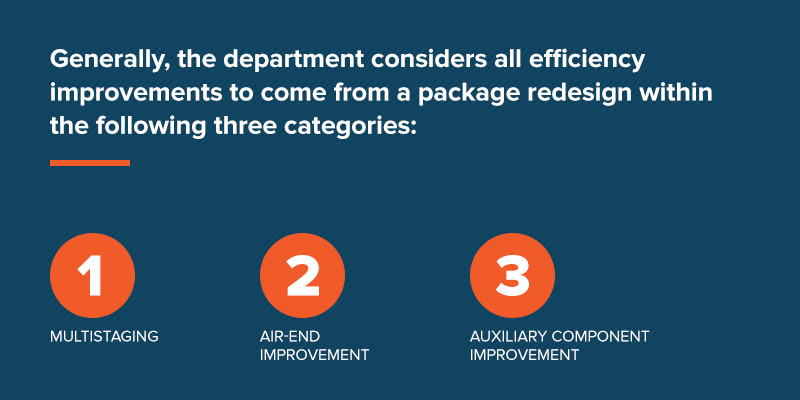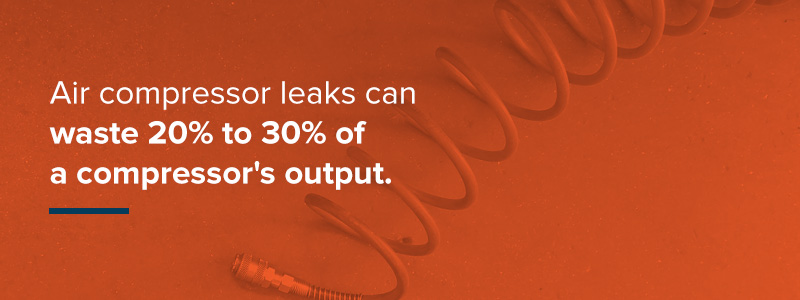Chapter 5: Requirements to Achieve Compliance With the DOE Standards
Some air compressor manufacturers may be concerned about reaching compliance with the standards by 2022. The department offers tips for creating compliant, energy-efficient air compressors, though it remains a challenge for smaller businesses. Nevertheless, air compressor manufacturers should consider what compliance entails to get started.
The department’s energy conservation program for air compressors and other products includes four parts — testing, labeling, the establishment of federal energy conservation standards and enforcement procedures. For commercial and industrial products, it is mostly the department’s responsibility to complete labeling requirements. Depending on certain criteria, the department is required to develop test procedures to measure the energy efficiency of each covered product — not the manufacturer. Instead, manufacturers of covered products must use the prescribed test procedures to show their products comply with the standards adopted under the EPCA. The department provides detailed test instructions for manufacturers.
In this chapter, we will look at the department’s recommendations for creating more efficient air compressors for manufacturers. We will also explore ways consumers of air compressor products can make their current air compressors more efficient.
How Manufacturers Can Meet New Compressor Standards
Generally, the department considers all efficiency improvements to come from a package redesign within the following three categories.

1. Multistaging
Compressors take in air and compress it to a higher pressure required for a specific application. The unit can perform compression in one or multiple stages. Units that compress the air in one stage are referred to as single-stage compressors, while units that use multiple stages for compression are called multistage compressors. The act of compression inevitably produces heat in a gas. When air is compressed slowly, the temperature of the gas never exceeds the temperature of the environment. This process is called isothermal.
Isothermal compression requires less work. If a compressor can dispel more heat, it requires less energy because hotter gas is more difficult to compress. Multistage compressors are engineered to divide the compression process into two or more stages. This allows heat removal between stages using a heat exchange device, sometimes called an intercooler. The benefits of multistage compressors include:
- Improved efficiency
- Improved reliability
- Less moisture buildup
- Fewer maintenance requirements
2. Air-End Improvement
The air-end is the location of the air compressor where the air is compressed. The efficiency of the air-end depends on the following factors:
- Operating speed
- Surface finish
- Manufacturing precision
- Compression chamber geometry
- Rated compressor output capacity
Instead of using one particular air-end in multiple compressor packages, manufacturers should redesign and develop air-ends to increase the efficiency of different compressor packages and applications.
3. Auxiliary Component Improvement
Just as with air-ends, each compressor package features multiple designs that affect efficiency including motors, fans, drains, valves and more. Isentropic efficiency, for example, can be increased by improving the efficiency of the fan or filters. Improving the design of any auxiliary part may increase the overall efficiency of a compressor package.
In summary, manufacturers should keep these three tips in mind to redesign and build more efficient air compressors that meet the department’s standards:
- Improve product design using proven technologies.
- Use multiple compressor stages with an intercooler.
- Improve the efficiencies of filters, dryers and other auxiliary components.
How Air Compressor Owners Can Save Energy Now
Although buying an energy-efficient air compressor is one sure way to cut energy costs, especially considering that operating an air compressor usually costs more than purchasing one, consumers can make their current air compressors more efficient by taking the following steps:
- Monitor and measure: Monitor and measure the compressed air system’s energy consumption to determine where to make adjustments.
- Turn it off: Turn off air compressors during evenings and weekends. By turning it off when you do not need to use it, you can reduce your electric bills by up to 20 percent.
- Fix leaks: Fix the largest holes and leaks first followed by the smaller ones. Leaks mean the air compressor will need a lot more power to maintain air pressure. Sometimes leaks waste 20 to 30 percent of a compressor’s output. Any air leak can cost you thousands of dollars a year.
- Prevent new leaks: It’s worth it to be proactive when it comes to leaks and your air compressor. To prevent a new leak, check the piping system and look for dust, sludge or any signs of corrosion. Dirt and dust can lead to corrosion fast, which eventually leads to leaks.
- Do not run beyond required pressures: Avoid raising the pressure even if leaks or clogged filters strain the equipment. You will have much higher energy costs if you do.
- Check drains: Check to see if the condensate drains are stuck and adjust them periodically, so you don’t waste compressed air.
- Optimize the piping system: Simple changes made to the piping system can make it easier for the compressor to transfer air. For example, increasing the size of a pipe by two to three inches can reduce pressure drop up to 50 percent. Air piping should be large enough to minimize pressure drop.
- Change filters regularly: Inspect and replace filters systematically. Dirty or clogged filters make an air compressor work harder which causes more energy use. A clean filter also reduces maintenance costs.
- Heat recovery: Reuse the heat generated by the air compressor using a heat exchanger to produce hot water or hot air. You can reuse as much as 90 percent of the heat.
- Prioritize proper maintenance: A properly-maintained air compressor will run more efficiently and last longer than one that is not maintained. Proper maintenance helps cut energy costs.
- Eliminate improper use of compressed air: Other energy sources may be more economical to use than compressed air. For example, using an air compressor for open blowing, cooling or drying is not a good idea regarding saving energy and costs. Instead, use a blower or a fan for these applications and save energy.
Contact Quincy Compressor for More Information
Lawmakers have come a long way to enforce energy conservation however they can. However, there are still many milestones to reach. Although consumers are not required by law to only use energy-efficient products, it’s a choice worth making. As energy conservation awareness spreads, more individuals are demanding efficient equipment and appliances to run their businesses and homes. Manufacturers must keep up with consumer demand, whether the DOE requires them to or not.
At Quincy Compressor, we’re ahead of the curve. We’ve adopted the new performance standards early on and are proud to be the first in the industry to test and publish according to the DOE energy conservation standards for air compressors. As a leading designer and manufacturer of reciprocating and rotary screw air compressors, Quincy Compressor is a name you can trust. All of our compressors are made in the United States and built to last decades of heavy use. If you need high-efficiency compressors, no matter what industry you’re in, we have the solution at Quincy. To learn more about our products and the new standards, contact us today or find a dealer near you.


